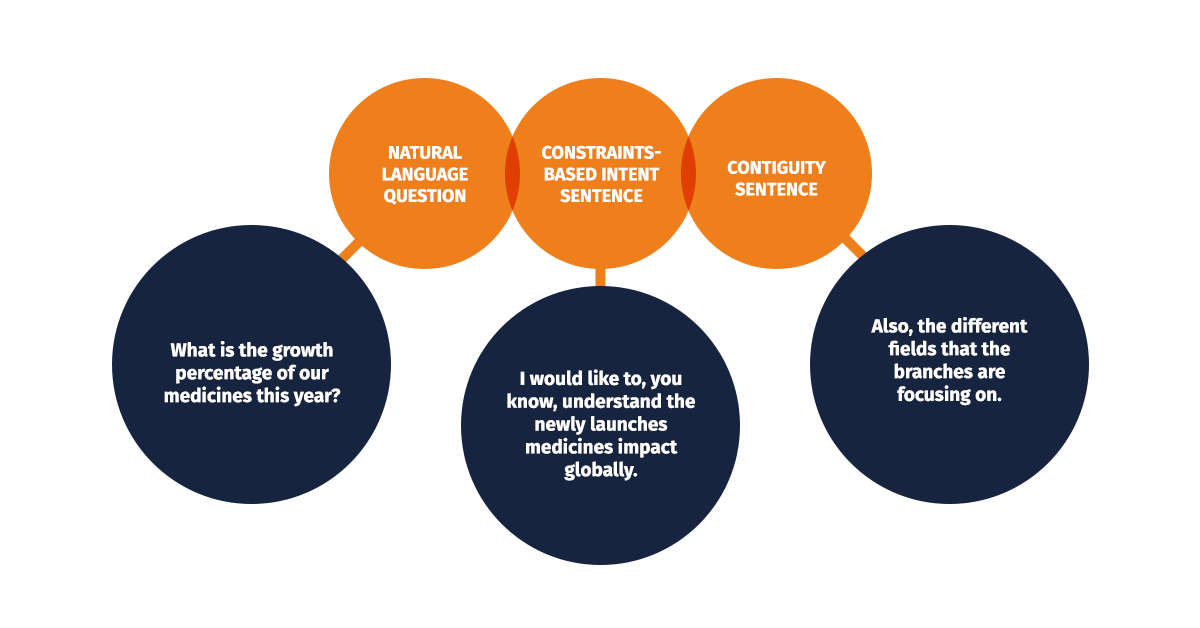
Natural Language Intent Recognition: Intelligent Audio Transcript Analytics Using Semantic Analysis to Understand User’s Intent
In the modern business landscape, timing is everything. Quickly identifying user’s intent can help you get a leg up your competition. How? It can enable you to respond actively to a potential customer’s interest and multiply your chances of influencing the key decision-makers through meaningful conversations.
But, if you receive thousands of customer interactions a day, detecting customer intent in your unstructured data is challenging. The good news is that you can automate intent classification with artificial intelligence, so you can identify intent in thousands of emails, social media posts, and more in real-time and prioritize responses to potential customers.
Raise your hand if you’re a business that’s finding it increasingly complex to detect user intent from voluminous unstructured data sets containing long-wielded sentences and juxtaposed multiple objectives. Chances are your hand is up.
The good news is that you now have a solution to this.
Overview of the Problem
Let’s take a typical client call example to understand the challenge here.

The above example shows that the call generally starts with some casual talk ( greetings). The client then states the objective of the call and has a detailed discussion. Finally, the client asks about the suggested next steps, another objective of the call.
What is Semantic Analysis in NLP?
Semantic analysis in NLP interprets the meaning behind words and sentences, enabling machines to understand human language contextually. It powers applications like sentiment analysis, intent recognition, and chatbots by decoding user intent from unstructured text.
What is Intent?
Simply put, refer to anything a user wants to accomplish
Now talking from a technical perspective, we define intent as a single or group of 2-3 contiguous sentences that can solely convey an idea with its necessary context. Extracting the call intent can lead to many downstream applications, such as better content creation and planning.
3 Challenges in Intent Recognition
We discussed some challenges in part-1 of this 4-blog series. Here we discuss three more challenges specific to intent recognition (or intent classification).
- There can be multiple intents present across the call transcript like we discussed in the example above.
- Differentiation between the client intent and details of the same. In the above example, differentiating between the intent, i.e., to know about the growth percentage or its details.
- Missing or incorrect punctuations leading to wrong sentences extracted as questions. For example, “I’m not sure what the report says?” having a question as wrong punctuation.
Tredence’s NL-IR Approach
Pre-processing
Cleaning and casual talk removal steps, mentioned in Part 1 of this 4-blog series, are followed to remove the unwanted sentences present in the transcripts. This important step highly affects the output of the next steps.
For instance, “How are you Cathy? How was your vacation?” should not be extracted by the Question Analytics module, which we will explore later in this blog. The intents are present throughout the call; however, we observed that 92% of the time, the intent was in the first half of the call. Hence, we focused on it to increase the precision of the system.
Feature extraction
- Natural Language Question Extraction: To extract questions that clients ask, we use Tredence Question Analytics NLP Accelerator that follows a hybrid approach ( combination of both rule-based and supervised approach). The rule-based approach leverages 5W-1H words and four generalized POS tag and Dependency parser patterns to detect the starting point of the interrogative part, if available, in a sentence. The supervised classifier was trained on ~100k questions’ data.
- Constraints-based Intent Sentence Extraction: Identify the objectives of the client that are not conveyed in the form of questions. Intent identification is done by skip-gram matching of two generalized Dependency parser patterns.
- Contiguity Sentence Extraction: We also extract the important sentences after the first extraction step to provide more context. The following sentences were extracted if they are tightly coupled with the preceding sentences identified by the conjunctions and other identifiers.
Let’s take the same example to know what types of sentences are extracted from each of the features described above.

Intent Segments Formation
Primarily, the intent segments are formed combining the contiguous sentences extracted by the methods stated above. However, simply combining the contiguous sentences can lead to many sentences in a segment that would decrease the system’s effectiveness.
The system divides the obtained segment into subsets with the least deviation in the number of sentences in each subset segment and with a maximum of 6 sentences in a subset segment. The splitting is done considering the continuity and similarity of sentences. These split segments are considered as final intent segments that will be fed into the next module.
Natural Language Intent Ranking
This module will rank the intent segments obtained from the above module. We use multiple signals to rank these segments.
- Topics: Used topics obtained from Key Concept Extraction mentioned in Part 2 of this blog series to boost the segments’ scores containing these concepts.
- Number of questions: Improve the score of the segments having a high number of questions.
- Importance of paragraph: Giving higher weightage to the segments in the bigger paragraph, having vital information.
- Summarization: Boost the score of the segments having TextRank + Bert summary sentences.
More signals can be added to domain-specific needs.
Dynamic number of Output Intents
Since there is no fixed number of intents that the clients ask in a call, providing a hard cut-off of Top “N” intents will not provide desirable output. Hence, the system is designed to automatically provide the dynamic number of intents corresponding to each transcript using a differential cut-off to identify the number of intents that needs to be provided as output.
Pipeline in action
Tredence has recently partnered with Fortune 100 Research and Advisory client to extract Intents discussed in their client inquiry calls. The whole pipeline is robust to multiple domains and industry sectors with minor modifications. The system has performed a near-human performance for hospitality and industrial & construction rental company client call data.

AUTHOR - FOLLOW
Neeti Nair
Data Scientist
Topic Tags
Next Topic
NLP anthology (Part 2) – Key concept extraction: intelligent audio transcript analytics extracting key phrases for scaling industrial NLP applications
Next Topic




